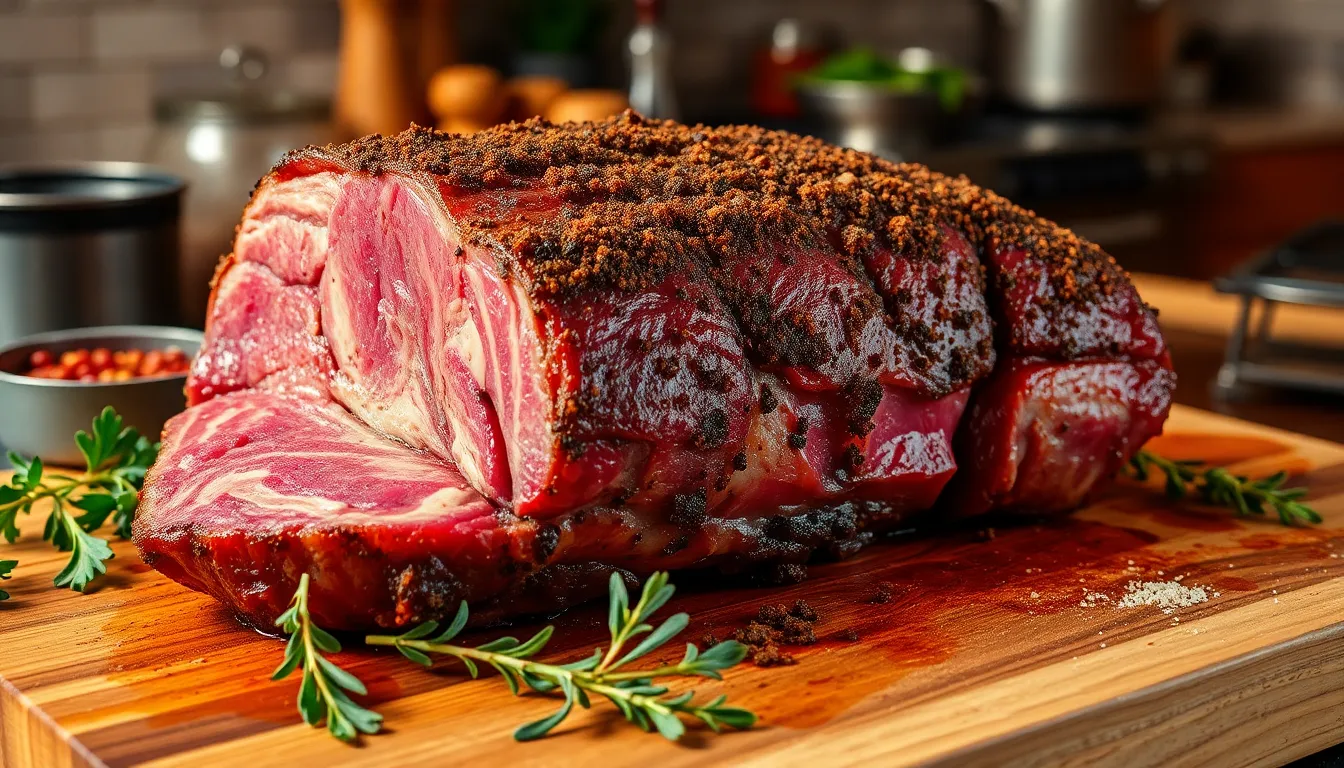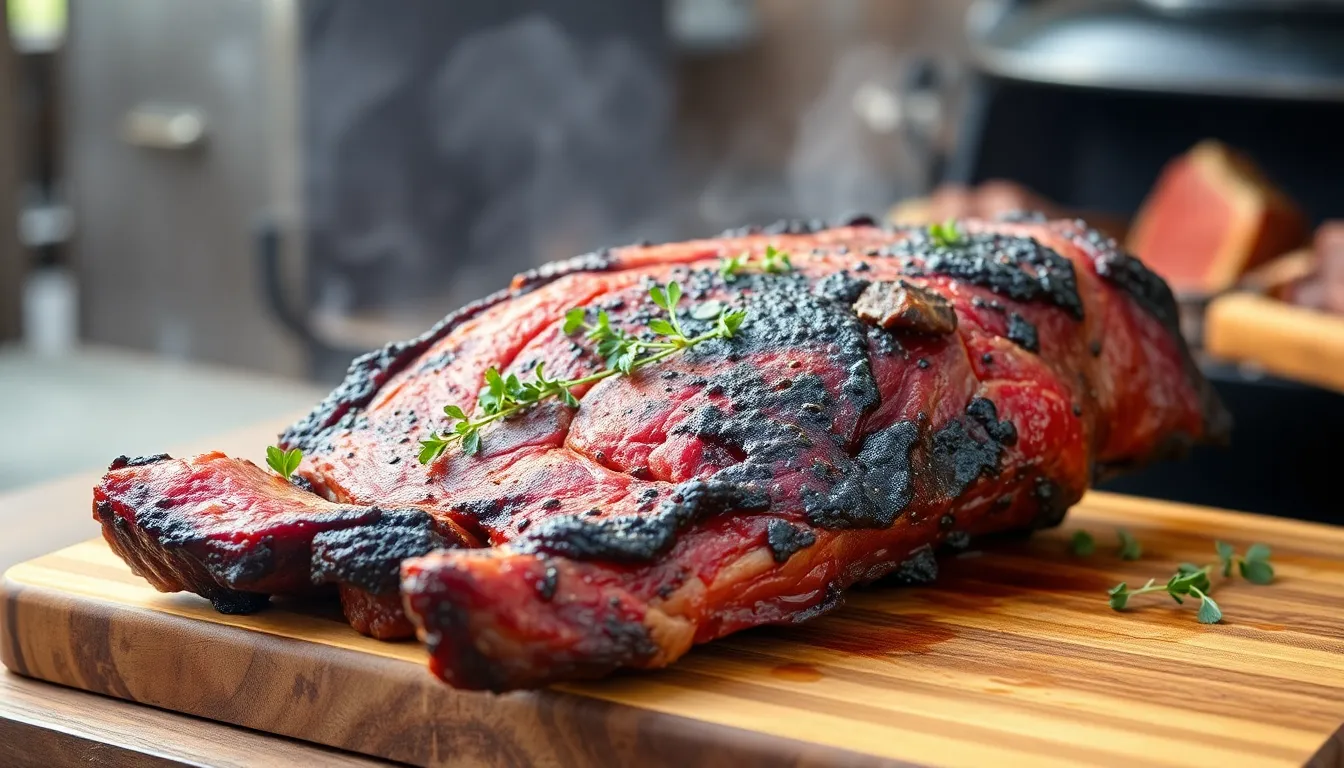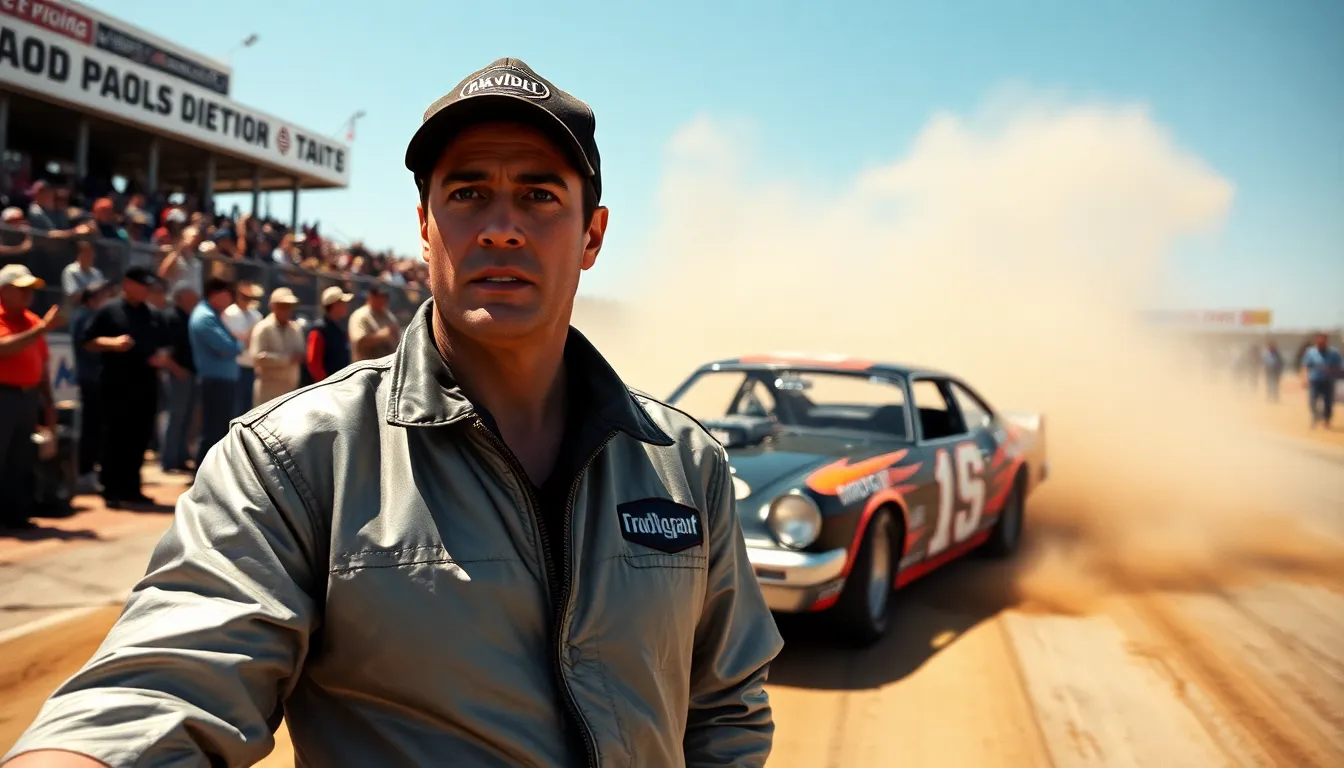Table of Contents
ToggleSmoking a prime rib can transform an ordinary meal into an extraordinary feast. With its rich flavor and tender texture, prime rib is a favorite for special occasions. However, the key to achieving that perfect smoky goodness lies in knowing exactly how long to smoke it.
Timing is crucial when it comes to smoking prime rib. Too little time can leave it undercooked, while too much can dry it out. Understanding the factors that influence cooking time, such as the size of the roast and the temperature of the smoker, can make all the difference. Whether you’re a seasoned pitmaster or a curious beginner, mastering the art of smoking prime rib will elevate your culinary skills and impress your guests.
Understanding Prime Rib
Prime rib is a prized cut of beef, known for its rich flavor and tenderness. Understanding its characteristics and the various cuts can enhance smoking techniques and result in a memorable meal.
What Is Prime Rib?
Prime rib, often referred to as standing rib roast, comes from the rib section of beef. This cut is typically served bone-in, which contributes to its unique flavor profile. It contains a high percentage of marbling, ensuring juicy and flavorful results when cooked. The USDA designates prime grade rib cuts as those with abundant marbling and superior tenderness, making them ideal for smoking or roasting.
Cuts of Prime Rib
Different cuts of prime rib offer unique attributes, influencing flavor and cooking methods. Key cuts include:
- Whole Rib Roast: This cut includes multiple ribs and serves as an impressive centerpiece for gatherings. It typically weighs between 6 to 16 pounds.
- Ribeye Roast: Cut from the center of the rib, the ribeye roast is known for its tenderness and flavor. It is a popular option for smaller gatherings.
- Bone-In Ribeye: Featuring a bone that enhances flavor during cooking, this cut provides a rich taste and is excellent for smoking.
- Boneless Ribeye: This cut lacks the bone but maintains a similar flavor profile and tenderness. It offers convenience for easier slicing and serving.
- Prime Rib Steak: These individual steaks are cut from the rib roast, providing all the prime rib flavor in a more manageable portion size.
Understanding these cuts aids in selecting the right piece for smoking, ensuring the best flavor and texture outcomes.
Preparing the Prime Rib

Preparing prime rib involves careful selection and seasoning to enhance its natural flavors. Proper preparation ensures a delicious and tender finished product.
Choosing the Right Prime Rib
Choosing the right cut of prime rib impacts the smoking outcome. Select a prime rib cut based on the following criteria:
- Grade: Opt for USDA Prime or Choice. USDA Prime offers superior marbling and flavor.
- Size: Choose between 2 to 5 pounds for smaller gatherings or larger cuts for bigger events.
- Bone-in vs. Boneless: Bone-in prime rib offers more flavor and juiciness, while boneless provides easier carving.
- Marbling: Look for even fat distribution, as it enhances flavor and tenderness during cooking.
Seasoning and Marinating
- Dry Rub: Apply a mixture of kosher salt, black pepper, garlic powder, and herbs. This enhances crust formation.
- Marinade: Marinate for 4 to 24 hours using a blend of olive oil, Worcestershire sauce, and fresh herbs. This adds moisture and flavor.
- Rest: Let the prime rib rest for 1 hour after seasoning. This allows the rub to penetrate the meat and promotes even cooking.
Smoking Techniques
Smoking prime rib requires understanding various techniques to achieve excellent results. Selecting the right smoker and maintaining ideal temperatures are crucial elements in this process.
Types of Smokers
- Offset Smokers: Offset smokers use a horizontal design where the firebox sits beside the cooking chamber. This design allows for indirect heat, providing even cooking and enhancing the smoky flavor.
- Vertical Smokers: Vertical smokers, or bullet smokers, feature multiple racks for placing meat. They use a water pan to maintain moisture and temperature, ideal for smoking prime rib.
- Electric Smokers: Electric smokers offer convenience and consistent temperatures. They maintain precise heat levels, reducing the risk of overcooking or undercooking prime rib.
- Pellet Smokers: Pellet smokers combine convenience and flavor. They use wood pellets as fuel, automatically feeding them into the fire, yielding a rich smoky taste while maintaining ease of use.
- Charcoal Smokers: Charcoal smokers provide a traditional smoking experience. They require more attention to maintain temperature but often deliver an unmatched flavor profile.
Ideal Smoking Temperature
- Low and Slow: Smoking prime rib benefits from cooking at low temperatures (225°F to 250°F). This method promotes tenderizing the meat and allows flavors to develop fully.
- Target Internal Temperature: Aim for an internal temperature of 130°F for medium-rare or 140°F for medium doneness. Using a meat thermometer ensures precision throughout the cooking process.
- Resting After Cooking: Allowing the smoked prime rib to rest for at least 30 minutes before slicing is crucial. Resting enables juices to redistribute, enhancing flavor and moisture in each serving.
How Long To Smoke A Prime Rib
Timing plays a crucial role in smoking prime rib, as both undercooking and overcooking can compromise its flavor and texture. Several factors influence the smoking duration needed to achieve the desired doneness.
Factors Affecting Smoking Time
- Size of the Roast: The weight of prime rib directly impacts cooking time. A general rule is to allocate 30 to 40 minutes per pound at 225°F to 250°F.
- Smoker Temperature: Higher temperatures reduce smoking time. For instance, smoking at 250°F decreases the overall cooking duration compared to 225°F.
- Bone-in or Boneless: Bone-in cuts often take longer to cook due to the bone’s thermal resistance. Expect an additional 15 to 30 minutes for bone-in roasts compared to their boneless counterparts.
- Desired Doneness: The target internal temperature varies based on preferred doneness levels. Medium-rare typically reaches 130°F, while medium runs around 140°F; these targets dictate smoking times.
- Weather Conditions: Cold or windy conditions can influence cooking times, often requiring adjustments to ensure consistent temperatures within the smoker.
Smoking Time Guidelines
| Roast Size (pounds) | Estimated Time (hours) | Internal Temp (°F) | Doneness Level |
|---|---|---|---|
| 2 | 1 to 1.5 | 130 | Medium-Rare |
| 3 | 1.5 to 2 | 130 | Medium-Rare |
| 4 | 2 to 2.5 | 130 | Medium-Rare |
| 5 | 2.5 to 3 | 130 | Medium-Rare |
| 2 | 1.5 to 2 | 140 | Medium |
| 3 | 2 to 2.5 | 140 | Medium |
| 4 | 2.5 to 3.5 | 140 | Medium |
| 5 | 3 to 4 | 140 | Medium |
Following these guidelines ensures prime rib achieves the ideal tenderness and flavor profile, making it a standout dish for any occasion. Accurate temperature monitoring is essential for optimal results.
Serving the Smoked Prime Rib
Serving the smoked prime rib involves careful attention to detail to ensure an exceptional dining experience. Proper techniques for resting and carving contribute significantly to the final presentation and flavor.
Resting the Meat
Resting the prime rib is crucial for flavor and moisture retention. After the smoking process, it’s essential to let the meat rest for at least 30 minutes, allowing the juices to redistribute throughout the roast. This period enhances tenderness, ensuring each serving is juicy and flavorful. Covering the meat loosely with foil helps maintain warmth without causing steaming, which could lead to loss of texture.
Carving Techniques
Carving the prime rib correctly showcases its quality and enhances the dining experience. Use a sharp carving knife to make clean, even slices. Start by removing the bones if the cut is bone-in; this makes slicing easier and cleaner. Slice against the grain for maximum tenderness, producing ½-inch to 1-inch thick pieces. Consistency in slice thickness ensures even serving and presentation, reflecting the care taken in preparation and cooking.
Smoking prime rib is an art that combines technique and patience. By understanding the nuances of timing and temperature, anyone can create a dish that impresses at any gathering. The right cut and seasoning elevate the experience further, ensuring each bite is tender and flavorful.
Taking the time to rest the meat after smoking is just as crucial as the cooking process itself. This step allows the juices to redistribute, resulting in a succulent final product. With careful attention to detail and a little practice, smoking prime rib can transform a meal into a memorable feast.



